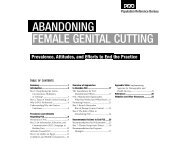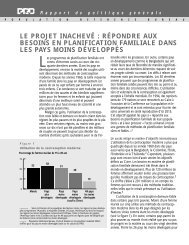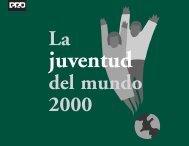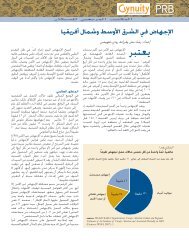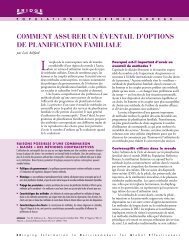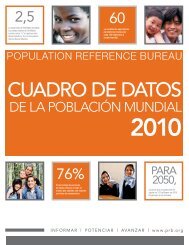Immigration Shaping America - Population Reference Bureau
Immigration Shaping America - Population Reference Bureau
Immigration Shaping America - Population Reference Bureau
You also want an ePaper? Increase the reach of your titles
YUMPU automatically turns print PDFs into web optimized ePapers that Google loves.
Figure 1<br />
U.S. Immigrants by Region of Birth, 1960s to 1990s<br />
Immigrants in millions<br />
6<br />
3.2<br />
38%<br />
11%<br />
40%<br />
11%<br />
1960–1969<br />
Latin <strong>America</strong><br />
Asia<br />
Europe<br />
Canada and other<br />
4.3<br />
41%<br />
35%<br />
20%<br />
5%<br />
1970–1979<br />
6.3<br />
42%<br />
43%<br />
11%<br />
5%<br />
1980–1989<br />
9.8<br />
51%<br />
30%<br />
13%<br />
6%<br />
1990–1999<br />
Note: The total for 1990 to 1999 includes 2.2 million immigrants who were legalized in 1987 and<br />
1988 and granted immigrant status in the early 1990s. The sum of the percentages may exceed 100<br />
because of rounding.<br />
Source: <strong>Immigration</strong> and Naturalization Service, Statistical Yearbook of the <strong>Immigration</strong><br />
and Naturalization Service, 1970 to 2001, selected years.<br />
tions on foreigners wishing to immigrate.<br />
A major policy change in 1965<br />
switched priority for entry from people<br />
with particular national origins<br />
to those with relatives in the United<br />
States and foreigners whom U.S.<br />
employers wanted to hire. The result<br />
was a shift from mostly European<br />
to mostly Latin <strong>America</strong>n and Asian<br />
immigrants.<br />
There are few limits on nonimmigrant<br />
visitors, and their numbers grew<br />
rapidly in the 1990s, as more tourists<br />
and business visitors streamed into the<br />
country and as more foreign students<br />
and foreign workers arrived. Illegal<br />
immigration also rose in the 1990s,<br />
making immigration a contentious<br />
public policy issue in the 21st century.<br />
<strong>Immigration</strong> and the integration of<br />
foreigners are much-debated issues;<br />
the debate is framed by the extreme<br />
views of those who advocate “no<br />
immigrants” and those who advocate<br />
“no borders.” The Federation for<br />
<strong>America</strong>n <strong>Immigration</strong> Reform<br />
(FAIR), for example, charges that<br />
immigrants contribute to population<br />
growth and environmental degradation,<br />
displace low-skilled <strong>America</strong>n<br />
workers, depress wages, and threaten<br />
the cultural bonds that hold <strong>America</strong>ns<br />
together. Consequently, FAIR<br />
calls for a sharp reduction in immigration—from<br />
1 million a year to perhaps<br />
300,000 a year—which FAIR<br />
feels would have the added benefit of<br />
allowing recent arrivals and <strong>America</strong>ns<br />
time to adjust to one another.<br />
At the other extreme, The Wall<br />
Street Journal, the leading U.S. newspaper<br />
for the business world, advocated<br />
a five-word constitutional amendment—“There<br />
shall be open borders”—in<br />
a 1990 editorial. After the<br />
Sept. 11 attacks, the Journal still advocated<br />
high levels of immigration,<br />
chiefly for their economic benefits:<br />
More people mean more consumers<br />
and more workers, which helps the<br />
economy grow. 2 Groups such as the<br />
Organization of Chinese <strong>America</strong>ns<br />
and the Emerald Isle <strong>Immigration</strong><br />
Center favor immigration from particular<br />
countries or regions. The<br />
Catholic Church and some other religious<br />
organizations oppose immigration<br />
controls because they believe<br />
that national borders artificially divide<br />
humanity. 3 Other groups support<br />
continued immigration because they<br />
think it is a defining part of the <strong>America</strong>n<br />
national identity.<br />
The United States is a nation of<br />
immigrants. U.S. presidents frequently<br />
remind <strong>America</strong>ns that,<br />
except for <strong>America</strong>n Indians, they or<br />
their forebears left other countries to<br />
begin anew in the United States, and<br />
that immigration permits individuals<br />
to better their lives while strengthening<br />
the United States. Yet immigration<br />
also brings many changes that<br />
raise fundamental questions for<br />
<strong>America</strong>ns. Who are we? What kind<br />
of a society have we built, and whom<br />
shall we welcome to it? What should<br />
we do to encourage the integration<br />
of newcomers? How should we deal<br />
with those who arrive uninvited?




